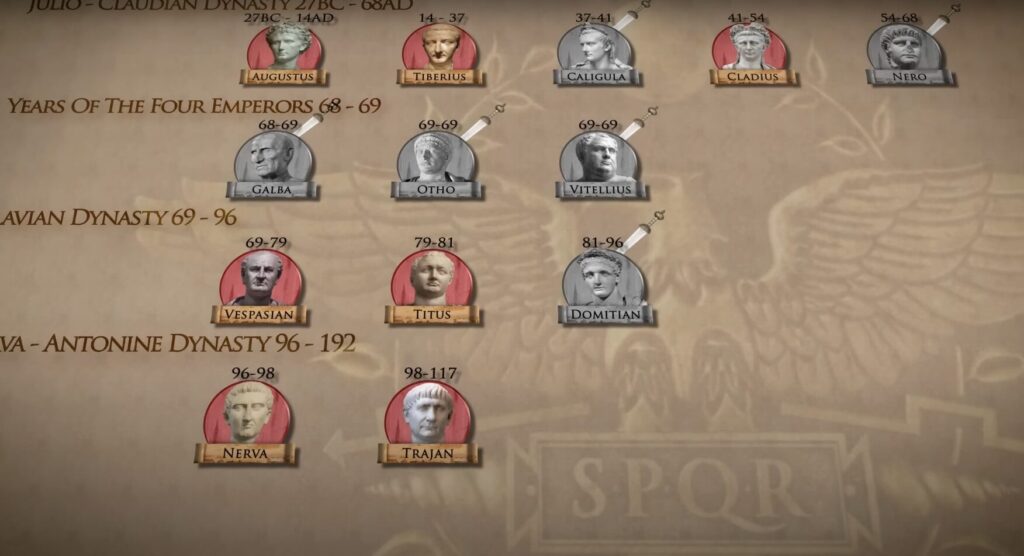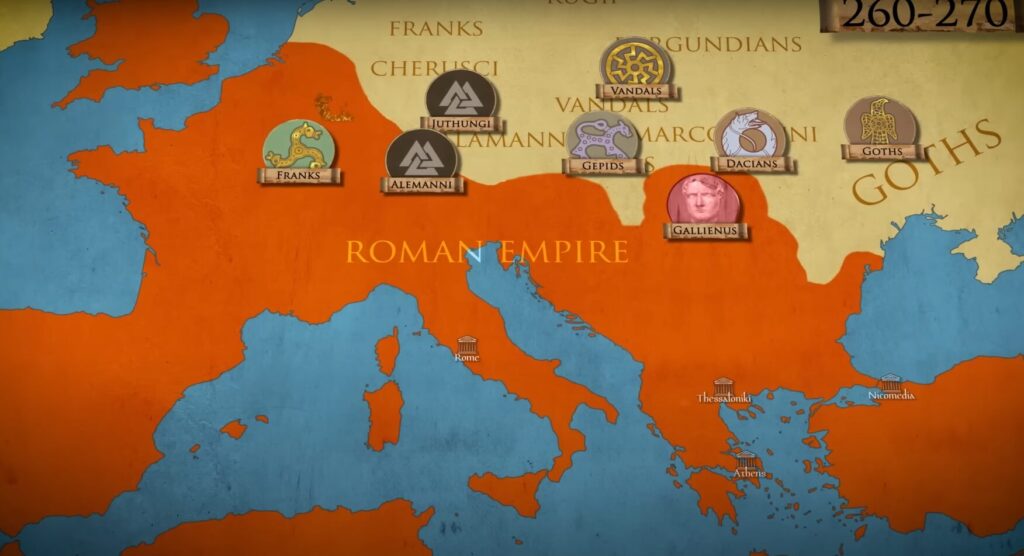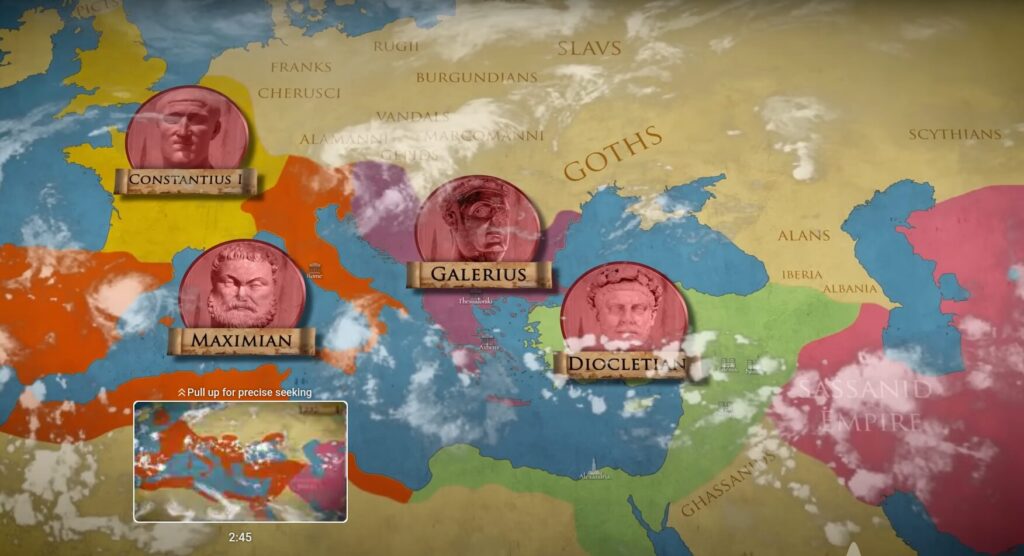For centuries, the Roman Empire experienced both moments of stability and times of crisis. Its early strength came from strong leadership, military power, and territorial growth, which helped the empire expand and thrive. However, changes in leadership, rising military costs, and economic troubles started to weaken the foundation of Rome.
During the third century, the Empire faced a series of serious challenges at home and abroad. Foreign invasions, internal divisions, and shifting power all contributed to a long period of unrest. This difficult period changed the direction of Roman history and influenced the future of the empire.
Key Takeaways
- Rome’s foundation was shaped by powerful rulers and expanding borders.
- Internal struggles and external threats led to a significant crisis.
- The third-century crisis caused lasting changes in Roman history.
Roots of Roman Imperial Power
Change from Republic to Single Ruler
The Roman state went through many changes before it became an empire. Civil wars created chaos, and power struggles were common. In 31 B.C., after the Battle of Actium, Gaius Octavian came out on top. He defeated Mark Antony and took control.
Instead of returning to the old republic, Octavian took the new title princeps, meaning “first citizen.” He kept up some parts of the old government, but real control stayed with him. Over time, the Senate had less and less power.
A table showing the major events during this shift:
| Year | Event |
|---|---|
| 31 B.C. | Octavian wins at Actium |
| 27 B.C. | Octavian becomes princeps (“first citizen”) |
| 68 A.D. | Nero is forced to die, causing disaster |
| 69 A.D. | Vespasian takes power, starts new dynasty |
Augustus Leads and Rule by First Citizen
Octavian, as the first emperor, used both his own authority and old republican traditions. The next rulers kept some of these traditions, calling themselves princeps instead of kings.
The rule that followed saw the Empire become more stable. Vespasian started a new family of rulers, followed by five leaders known for being wise and fair. During this time, the Roman Empire grew to its largest size under Trajan.
Later emperors, like Hadrian, stopped expanding. Marcus Aurelius faced wars at the borders, but the empire stayed strong. The foundation laid by Augustus and his successors shaped how Rome was governed for hundreds of years.
Key features of this era:
- The emperor had the real power, but old titles stayed
- Emperors tried to appear as servants of the people
- Stability was valued over expansion
Growth and Dominance of the Roman Empire
Turbulence and the Struggle for Leadership
After Nero’s downfall in 68 A.D., Rome entered a year filled with unrest and power struggles. Several men claimed leadership, which created confusion and weakened the system. Eventually, Vespasian rose above the others and took charge, starting the Flavian family line and helping the empire regain some order.
Eras of Calm and the Rule of Respected Leaders

Once the Flavian family established its rule, a stretch of steady governance followed. This period, marked by five especially effective rulers, brought peace, improved the economy, and allowed Roman society to thrive. These leaders focused on justice, fairness, and building strong institutions.
Trajan’s Territorial Advances
Under Trajan, Rome reached its largest size. He led campaigns that added new lands to the empire, stretching its borders to their furthest extent. Trajan’s rule is often noted for both its military victories and the construction of new public works throughout Rome.
Territories Added Under Emperor Trajan
| Region | Modern-Day Location |
|---|---|
| Dacia | Romania |
| Parts of Arabia | Jordan, Saudi Arabia |
| Mesopotamia | Iraq |
Hadrian’s Focus on Defence
Rather than seeking more land, Hadrian decided the time was right to protect what Rome already controlled. He built strong defensive lines, such as the famous wall in Britain, to keep out invaders. Hadrian also worked to keep the army well-organized and morale high by visiting different provinces and listening to local concerns.
Key Fortifications Built by Hadrian:
- Hadrian’s Wall (northern Britain)
- Fortress upgrades in Syria and North Africa
Hadrian’s policies marked a clear shift from expansion to protection and stability within the empire’s borders.
The Road to Turmoil: The Era of the Severan Family
Changes in the Roman Army

The rulers from the Severan family increased the number of soldiers in the Roman army. Regular troops were doubled, and pay was raised by half. This focus on the army’s power made the military the center of the empire’s strength, and soldiers became more involved in political matters.
Key Effects:
- Army size expanded
- Soldiers’ pay increased by 50%
- Military gained more control over politics
Financial Troubles and Currency Decline
To handle the cost of the larger army, Severan leaders reduced the amount of silver in Roman coins. As a result, the economy started to struggle. Coins lost value, and people became less confident in the empire’s money.
| Problem | Result |
|---|---|
| Lower silver in coins | Higher prices (inflation) |
| Bigger army expense | Financial strain on the state |
| Wages for soldiers | Devalued currency |
The Fall of the Senate’s Influence
Power shifted away from the Senate to the army and the emperor’s close advisors. The Senate lost many of its old privileges and became less important. Decisions that once involved senators were now made mostly by military leaders and the emperor.
- Senators had less say in key decisions
- Political power moved to army officials
- The Senate’s traditional role weakened
Reasons Behind the Crisis of the Third Century
Power Struggles and Soldier-Emperors
After the murder of Alexander Severus, the Roman Empire saw rapid changes in leadership. The army became the main force deciding who ruled. Over fifty years, about thirty rulers—often called “soldier-emperors”—rose to power.
Many of these leaders were chosen by soldiers in the field, not by legitimate succession. This led to almost constant civil wars and rebellions.
Key impacts:
- Unstable rule and short reigns
- Repeated revolts and assassinations
- Loss of central authority
Rising Pressure from Outside Enemies
The empire’s borders were under attack from many directions.
Germanic tribes such as the Goths, Vandals, and Alemani raided across the Rhine and Danube rivers. In the east, the Sassanid Empire pushed into Roman territory, capturing important cities like Antioch.
Main threats:
| Frontier | Invaders |
|---|---|
| Rhine-Danube | Goths, Vandals, Alemani |
| Eastern Provinces | Sassanid Empire |
These attacks put great stress on Roman leaders and armies, and forced the empire to split its focus across several fronts.
Financial Troubles and Economic Breakdown
The size of the Roman army grew a lot during this time. To pay these troops higher wages, emperors weakened their currency by using less silver in coins. This led to inflation and problems with trade.
Wars and invasions hurt local economies, while grain shortages—especially after losing Egypt—caused more hardship.
The economy suffered from:
- Lower-value money
- Crop failures and food shortages
- Tax collection issues
This cycle of financial trouble made it even harder for the emperors to rule effectively and protect the empire.
Key Turning Points During the Third Century Crisis
Defeat at Edessa and Captivity of Emperor Valerian
The Roman army, led by Valerian, marched east to protect its territories from the Sassanid Empire. In a major battle near Edessa, Valerian’s large force suffered a major defeat by Shapur I. Valerian was taken captive, the first time a Roman emperor was captured alive by an enemy. This defeat left the eastern provinces exposed and greatly weakened Roman control in the region.
| Event | Date | Outcome |
|---|---|---|
| Battle Near Edessa | 260 CE | Valerian defeated and captured |
The Gallic Region Breaks Away
As the central power struggled, a military commander named Postumus set up a separate state in Gaul and Britannia. He took advantage of the Roman emperor’s absence to claim these western provinces. This split reduced the size of the Roman Empire and made it harder to fight off new threats.
Key facts:
- Postumus ruled independently in the West.
- The Gallic state included Gaul, Britannia, and parts of Hispania.
- Multiple battles took place between Roman forces and the breakaway state.
Palmyra in the East Rises to Power
With the eastern Roman provinces under pressure, Odaenathus from Palmyra pushed back against invaders and stabilized the region. Over time, his family—especially his widow Zenobia—built a powerful eastern realm. Under Zenobia, the Palmyrene state managed to take over large parts of Egypt and Anatolia, controlling vital trade routes and resources.
Features of Palmyrene rule:
- Strong local leadership
- Expansion into Egypt and Anatolia
- Temporary independence from Rome
Uprisings and the Splitting of the Empire
Throughout this period, Rome faced rebellions by local commanders and soldiers. Many new rulers came and went, often after only a short reign. Large areas of the empire broke off into rival states, making Roman authority weaker than ever.
Summary Table:
| Region | Rebel State | Time Frame | Outcome |
|---|---|---|---|
| West | Gallic regime | 260–274 CE | Eventually defeated |
| East | Palmyrene regime | 260s–272 CE | Reabsorbed by Rome |
| Various | Military uprisings | 3rd Century | Frequent leadership changes |
Important Leaders During the Crisis
Gallienus and His Challenges
Gallienus ruled during a time of chaos for Rome. His father, Valerian, was captured by enemy forces, leaving Gallienus in charge while the empire faced attacks and uprisings. He fought off Germanic tribes near Mediolanum and managed to win battles even when outnumbered. Despite victories, he dealt with constant rebellions and saw parts of the empire, like Gaul and Britannia, break away under leaders such as Postumus.
Quick Facts about Gallienus:
- Faced invasions from several directions
- Lost and tried to reclaim western regions
- Dealt with frequent uprisings by rivals
Odaenathus and Zenobia
Odaenathus, a noble from Palmyra, defended the eastern provinces after the capture of Valerian. He reclaimed land from the Sassanids and pushed back against their advances, even reaching their capital. After Odaenathus was killed, his wife, Zenobia, became regent for their son and gained control of major eastern regions, including Egypt and parts of Anatolia.
Accomplishments:
- Odaenathus: Drove out invasions, restored eastern borders
- Zenobia: Expanded rule to Egypt and Anatolia, declared her son emperor
| Leader | Area Controlled | Major Action |
|---|---|---|
| Odaenathus | Eastern Roman provinces | Defeated Sassanids |
| Zenobia | Palmyran Empire | Seized Egypt, Anatolia |
Claudius II and His Military Achievements
After Gallienus’s death, Claudius II took control during heavy threats from the Goths and other groups. He won a large battle at Naissus, which greatly weakened the Gothic threat. Claudius also stopped invasions by Germanic tribes but died of plague before finishing his campaigns.
Key Achievements:
- Victory at Naissus with heavy enemy losses
- Pushed back Germanic attacks at Lake Benacus
- Reclaimed some areas from rebel rule
Aurelian and Restoring Roman Unity
Aurelian came to power when Rome was close to collapsing. He quickly defeated invading tribes and then focused on retaking the lost parts of the empire. He forced Zenobia’s surrender, bringing the eastern provinces back under Roman control. Later, he defeated the Gallic Empire at the Battle of Châlons, reuniting Gaul and Britannia with Rome.
Aurelian’s Highlights:
- Reclaimed eastern lands from Zenobia
- Won back Gaul and Britannia by force
- Strengthened borders by giving up risky provinces like Dacia
- Helped Rome recover from grain shortages
List of Regions Reunited Under Aurelian:
- Eastern provinces (former Palmyran territory)
- Gaul
- Britannia
Aurelian’s actions set the stage for the end of the crisis and the restoration of order in Rome.
Influence of Outside States

Attacks from the Sassanid Kingdom
The rise of the Sassanid Kingdom in the east placed enormous stress on Rome. Starting in 232, Rome’s eastern borders became a target for invasion as the Sassanids looked to claim territory. In 252, under Shapur I, they captured the city of Nisibis. The next year, they won a major battle at Barbalissos, allowing them to take Antioch as well.
The pressure from the Sassanids forced Roman emperors to focus attention and troops on the region. Emperor Valerian himself marched east but suffered defeat. He was captured with his army at Edessa—the first Roman emperor taken prisoner in battle. This event seriously weakened Roman control and morale. Later, Odaenathus from Palmyra helped turn the tide, recovering land and even reaching the Sassanid capital, but eastern Rome remained unstable.
Invasions by Goths and Germanic Peoples
While trouble grew in the east, groups like the Goths, Vandals, and Allemani began violent raids across the northern frontiers. These attacks targeted important provinces along the Rhine and Danube. The invasions reached a crisis point when tens of thousands of Goths entered Roman territory, moving even into Asia Minor.
Western provinces suffered continuous attacks. When the Allemani pushed into northern Italy, Emperor Gallienus beat them near Mediolanum, despite being outnumbered. Later, Claudius II stopped a huge Gothic invasion at Naissus. Roman sources claim over 50,000 Goths died in that campaign. Repeated attacks forced difficult choices; for example, the Romans abandoned the province of Dacia because it became too hard to defend.
List of Major Incursions:
- 252: Sassanids take Nisibis
- 253: Sassanids capture Antioch
- 259: Goths invade Asia Minor
- 269: Goths defeated at Naissus
- 271: Allemani invade northern Italy
These frequent invasions from both east and west kept pressure on the empire. Rome’s leaders had to split their attention, making it very hard to recover and defend all their provinces.
Repair and Results
Military Actions and Changes Under Aurelian
Aurelian became emperor during a very troubled time. He quickly moved the army to push enemy groups like the Vandals out of northern Italy. He also stopped several Germanic invasions at battles such as Fano and Pavia.
To make the empire safer, Aurelian left the province of Dacia since it was too exposed beyond the Danube. He then focused on the eastern parts of the empire. After defeating the Palmyrene forces led by Zenobia in 272, Aurelian recovered lands lost in the east and brought back much-needed stability. Later, he used military force at the Battle of Châlons to bring Gaul and Britannia back under Roman control.
The table below summarizes Aurelian’s main campaigns:
| Region | Main Action | Outcome |
|---|---|---|
| Northern Italy | Defeated Vandals | Restored order |
| Dacia | Abandoned province | Reduced threat, lost territory |
| Eastern Empire | Defeated Palmyrenes | Regained Egypt and more |
| Western Empire | Fought Gallic Empire | Reunited Gaul and Britannia |
Diocletian’s Rise and Influence
After Aurelian’s sudden death, Rome fell into another period of chaos. In less than ten years, six emperors rose and fell. Diocletian finally secured the throne in 284. He put an end to the constant power struggles by taking strong control.
Diocletian’s rule saw many military actions, but his rise brought relief from years of division. Each region was brought back under stronger imperial rule, and the empire slowly began to recover.
Some important results of Diocletian’s rise:
- Fewer quick changes of rulers
- More power given directly to the emperor
- Start of a new chapter in Roman rule
Political and Financial Changes
Both Aurelian and Diocletian understood that Rome needed more than just strong armies. They made new rules to fix the empire’s money and its leadership.
- Aurelian improved the quality of coins, which helped people trust Roman money again.
- Diocletian ordered a census to help with taxes and keep better records.
- He also set rules for prices, though many of these did not work as planned.
Important points about these reforms:
- Soldiers and workers were paid with more stable coins.
- The government tried to watch prices, but this caused problems and was hard to enforce.
- Taxes became more organized, helping the empire collect what it needed.
These actions helped put the Roman Empire back together and gave it a foundation to survive in the coming years.
Lasting Impact of the Crisis in the Third Century
The crisis in the third century deeply changed the Roman Empire’s structure. It caused political chaos, as about 30 different military leaders fought for the throne in just fifty years. Many soldiers became emperors, making the army the strongest power in the empire.
Economic Challenges
- The government reduced the silver content in coins.
- Pay for soldiers increased by 50%, placing extra strain on the economy.
- Inflation and currency problems became common.
Social and Military Shifts
- The size of the army doubled to deal with rising threats.
- The Senate lost much of its influence as military leaders took control.
- New enemies attacked the borders, forcing Rome to abandon provinces like Dacia.
Short-term Separations and Reconquests
| Name | Area Controlled | Time of Independence |
|---|---|---|
| Gallic Empire | Gaul, Britannia, Hispania | 260-274 |
| Palmyran Empire | Egypt, Syria, Anatolia | 271-272 |
These breakaway states showed how divided the empire became during this time. Later, emperors like Aurelian reunited these lands, but only after years of violence.
Reforms by leaders such as Diocletian tried to solve these issues. He introduced a new census, changed laws, and stabilized the empire to end the cycle of crisis. The decisions made during this period had effects that lasted for centuries, shaping how the empire functioned afterward.
